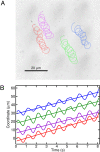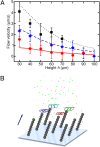Self-assembled artificial cilia
- PMID: 19934055
- PMCID: PMC2836646
- DOI: 10.1073/pnas.0906819106
Self-assembled artificial cilia
Abstract
Due to their small dimensions, microfluidic devices operate in the low Reynolds number regime. In this case, the hydrodynamics is governed by the viscosity rather than inertia and special elements have to be introduced into the system for mixing and pumping of fluids. Here we report on the realization of an effective pumping device that mimics a ciliated surface and imitates its motion to generate fluid flow. The artificial biomimetic cilia are constructed as long chains of spherical superparamagnetic particles, which self-assemble in an external magnetic field. Magnetic field is also used to actuate the cilia in a simple nonreciprocal manner, resulting in a fluid flow. We prove the concept by measuring the velocity of a cilia-pumped fluid as a function of height above the ciliated surface and investigate the influence of the beating asymmetry on the pumping performance. A numerical simulation was carried out that successfully reproduced the experimentally obtained data.
Conflict of interest statement
The authors declare no conflict of interest.
Figures




Similar articles
-
Magnetically-actuated artificial cilia for microfluidic propulsion.Lab Chip. 2011 Jun 21;11(12):2002-10. doi: 10.1039/c0lc00411a. Epub 2011 Feb 18. Lab Chip. 2011. PMID: 21331419
-
Analysis of fluid flow around a beating artificial cilium.Beilstein J Nanotechnol. 2012;3:163-71. doi: 10.3762/bjnano.3.16. Epub 2012 Feb 24. Beilstein J Nanotechnol. 2012. PMID: 22428106 Free PMC article.
-
Fluid transport at low Reynolds number with magnetically actuated artificial cilia.Eur Phys J E Soft Matter. 2009 Feb;28(2):231-42. doi: 10.1140/epje/i2008-10388-1. Eur Phys J E Soft Matter. 2009. PMID: 19030903
-
Microfluidic manipulation with artificial/bioinspired cilia.Trends Biotechnol. 2013 Feb;31(2):85-91. doi: 10.1016/j.tibtech.2012.11.005. Epub 2012 Dec 12. Trends Biotechnol. 2013. PMID: 23245658 Review.
-
Microscale imaging of cilia-driven fluid flow.Cell Mol Life Sci. 2015 Mar;72(6):1095-113. doi: 10.1007/s00018-014-1784-z. Epub 2014 Nov 23. Cell Mol Life Sci. 2015. PMID: 25417211 Free PMC article. Review.
Cited by
-
Microfluidic Magnetic Mixing at Low Reynolds Numbers and in Stagnant Fluids.Micromachines (Basel). 2019 Oct 29;10(11):731. doi: 10.3390/mi10110731. Micromachines (Basel). 2019. PMID: 31671753 Free PMC article. Review.
-
Bioinspired cilia arrays with programmable nonreciprocal motion and metachronal coordination.Sci Adv. 2020 Nov 6;6(45):eabc9323. doi: 10.1126/sciadv.abc9323. Print 2020 Nov. Sci Adv. 2020. PMID: 33158868 Free PMC article.
-
Development of a Simple Fabrication Method for Magnetic Micro Stir Bars and Induction of Rotational Motion in Chlamydomonas reinhardtii.Micromachines (Basel). 2022 Oct 27;13(11):1842. doi: 10.3390/mi13111842. Micromachines (Basel). 2022. PMID: 36363863 Free PMC article.
-
Biomimetic cilia arrays generate simultaneous pumping and mixing regimes.Proc Natl Acad Sci U S A. 2010 Sep 7;107(36):15670-5. doi: 10.1073/pnas.1005127107. Epub 2010 Aug 26. Proc Natl Acad Sci U S A. 2010. PMID: 20798342 Free PMC article.
-
A new class of magnetically actuated pumps and valves for microfluidic applications.Sci Rep. 2018 Jan 17;8(1):933. doi: 10.1038/s41598-018-19506-8. Sci Rep. 2018. PMID: 29343852 Free PMC article.
References
-
- Squires TM, Quake SR. Microfluidics: Fluid physics at the nanoliter scale. Rev Mod Phys. 2005;77:977–1026.
-
- Whitesides GM. The origins and the future of microfluidics. Nature. 2006;442:368–373. - PubMed
-
- Purcell EM. Life at low Reynolds number. Am J Phys. 1977;45:3–11.
-
- Gray J. Ciliary Movement. Cambridge, UK: Cambridge Univ Press; 1928.
Publication types
MeSH terms
Substances
LinkOut - more resources
Full Text Sources
Other Literature Sources

